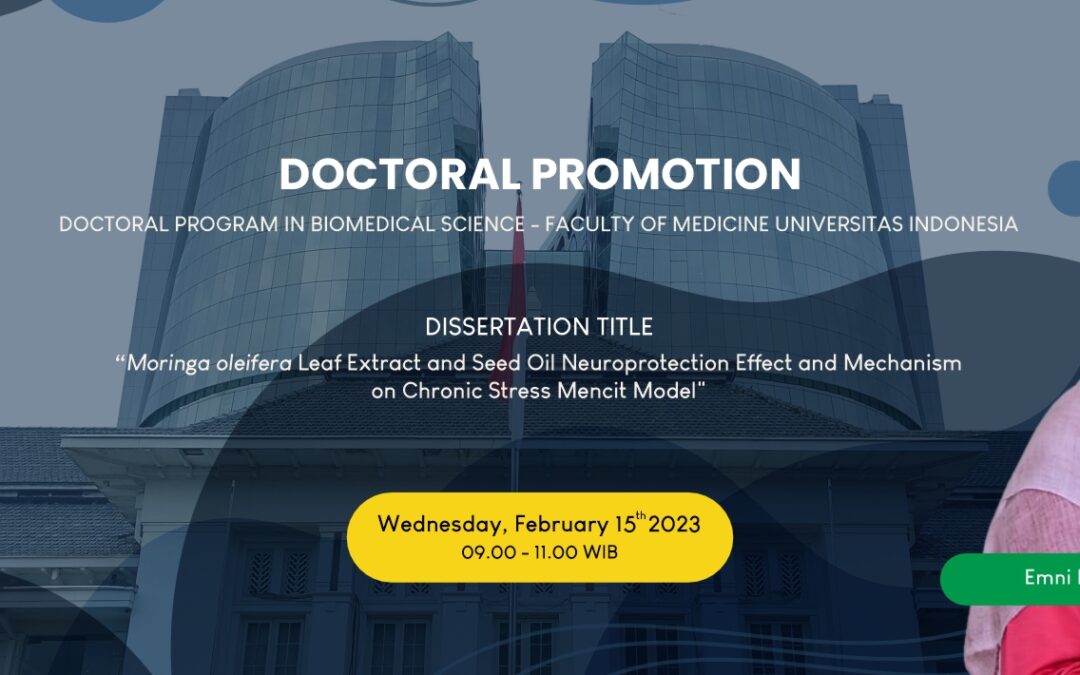Oleh: Dr. Emni Purwoningsih, S.Pd., M.Kes
Stres tidak dapat dihindarkan di dalam kehidupan sehari-hari. Sementara stres yang kronis dapat menimbulkan dampak negatif terhadap kesehatan, diantaranya gangguan mood dan gangguan fungsi kognitif. Kondisi tersebut dapat menurunkan kualitas hidup seseorang, bahkan dapat menimbulkan kecacatan pada penderitanya. Saat ini pengobatan yang diberikan pada stres kronis adalah dengan farmakoterapi, dan psikoterapi untuk mengurangi gejala. Pemberian suplemen untuk perbaikan fungsi otak sangat diperlukan, sebagai langkah preventif dari efek stres kronik. Berbagai studi neuroprotektif daun dan biji kelor pada hewan model telah dilakukan. Namun studi efektifitas kelor terkait kecemasan, depresi dan penurunan fungsi kognitif akibat stres kronik masih belum diketahui. Dengan demikian penelitian ini dilakukan untuk menganalisis efek neuroprotektif Ekstrak etanol 70% daun (MOE) dan minyak biji (MOO) Moringa oleifera pada hewan model yang diinduksi stres kronis. Penelitian ini difokuskan pada mekanisme BDNF, kolinergik dan glutamatergik.
Tahapan penelitian diawali dengan analisis fitokimia pada MOE dan MOO. Selanjutnya menggunakan hewan model stres kronik yang diinduksi water immersion restraint stres (WIRS), yang menggabungkan stresor fisik dan psikologis. Induksi WIRS dilakukan selama 16 hai. Selanjutnya pemberian MOE dengan dosis 400 dan 800 mg/kg BB, dan MOO dengan dosis 1 dan 2 m//kg BB selama 23 hari. Pengukuran perubahan prilaku dilakukan dengan Open field test (OFT) untuk mengukur kecemasan pada hari ke 17 dan 18, Forced swim test (FST) untuk mengukur depresif pada hari ke 19. Uji dilakukan pada semua kelompok. uji perubahan spontan dilakukan dengan menggunakan Y-maze pada hari ke 20 dan 21. Uji Novel object recognition (NOR) untuk mengukur kemampuan mencit mengenali objek baru di lingkungannya dilakukan pada hari 22 dan 23. Pada hari ke 24 dilakukan terminasi. Sampel kemudian diambil jaringan otak dan lambung untuk pemeriksaan histologi dan imunihistokimia. Sedangkan kelompok lainnya tanpa perfusi, untuk diambil hipokampus dan prefrontal kortek untuk analisis molekuler.
Hasil penelitian ini bahwa kandungan fitokimia MOE dengan LC-MS/MS menunjukkan adanya Flazin, Kaempferol-3-O-rutinoside, Kaempferol-7-O-α-L-rhamnoside, Kaempferol-3-O-β-D-glucopyranoside, Quercimeritrin, Stearidonic acid, Trichosanic acid, Azedarachin C, Phyrophaeophorbide A. Kandungan fitokimia pada MOO dengan GC-MS terdeteksi adanya senyawa Stigmasterol, 7-Octadecenoic acid, methyl ester, Alpha tocopherol, Cholest-5-en-3-ol, 23-ethyl-, (3. Beta., 23S), 6-Octadecenoic acid, (9E)-9-Octadecenoid acid, dan (9Z)-9-Octadecenal.
Pemberian MOE 400 mg/kg BB dan MOO 1 mL/kg BB dapat memperbaiki fungsi memori paling baik selanjutnya MOE dosis 400 dan 800 mg/kg BB dapat menurunkan tingkat depresi dan ansietas yang paling optimal. Mekanisme yang mendukung perbaikan kognitif dan gangguan mood ini melalui jalur kolinergik dan peningkatan kadar BDNF.
Sebagai simpulan MOE dan MOO berpotensi sebagai neuroprotektif pada efek stres kronis. Namun penelitian tentang senyawa aktif pada MOE dan MOO yang memberikan efek farmakologis paling efektif masih perlu dilakukan. Selanjutnya penelitian untuk melihat efek MOE dan MOO melalui mekanisme dibutuhkan penelusuran lebih lanjut.


